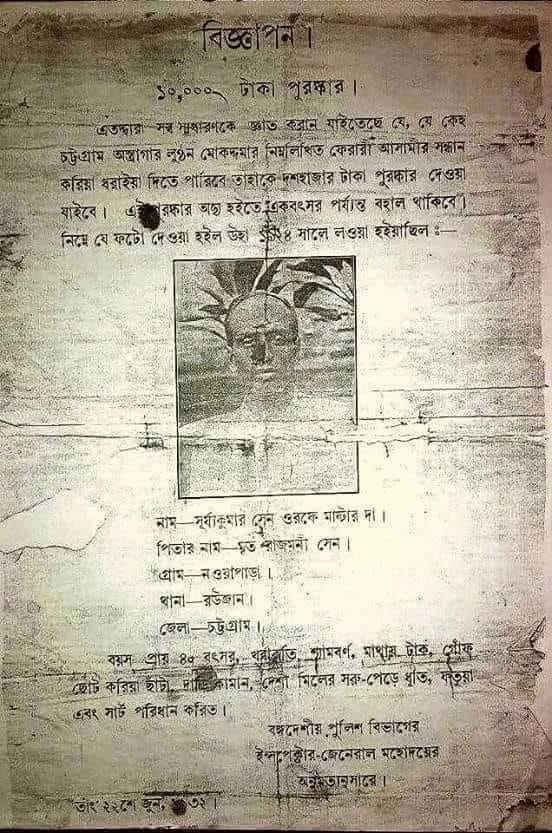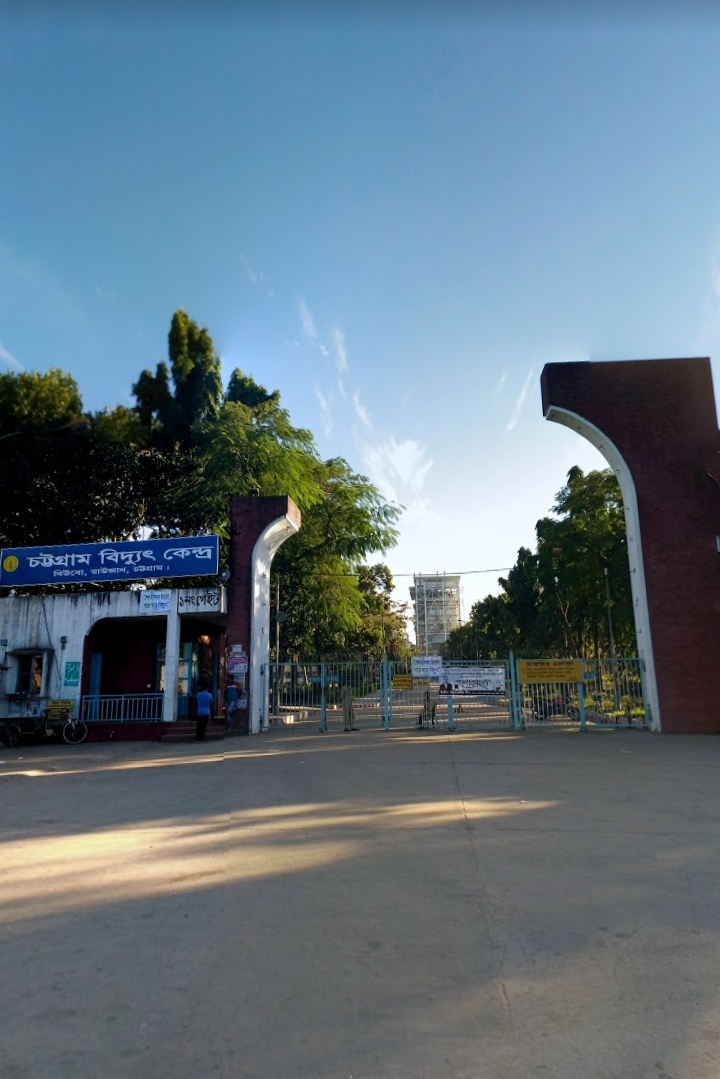|
Surya Sen
Surya Sen, also called Surya Kumar Sen (22 March 189412 January 1934), was an Indian revolutionary who was influential in the Indian independence movement against British rule in India and is best known for leading the 1930 Chittagong armoury raid. Sen was a school teacher by profession and was popularly known as ''Master Da'' ("da" is an honorific suffix in Bengali language). He was influenced by the nationalist ideals in 1916 while he was a student of B.A. in Berhampore College (Now MES College). In 1918, he was selected as president of the Indian National Congress's Chittagong branch. Sen was known for recruiting a group of young and passionate revolutionaries known as the Chittagong group. The group included Ananta Singh, Ganesh Ghosh and Lokenath Bal, and fought against the British stationed in Chittagong. He was an active participant in the Non-co-operation movement and was later arrested and imprisoned for 2 years from 1926 to 1928 for his revolutionary activities. A ... [...More Info...] [...Related Items...] OR: [Wikipedia] [Google] [Baidu] |
Raozan Upazila
Raozan,gohira ( bn, রাউজান) is an upazila of Chattogram District, in Chattogram Division, Bangladesh. It was established in 1947. Geography Raozan has 45,777 households and a total area of 246.58 km2. The two main rivers are Karnaphuli and Halda. Raozan is surrounded by Fatikchhari Upazila on the north, Boalkhali Upazila and Karnafuli river on the south, Rangunia and Kawkhali (Rangamati) Upazilas on the east, and Hathazari and Fatikchhari Upazila on the west. The river Karnaphuli flows on the south side of the Raozan Upazila and the river Halda flows on the west side. Historical events From about 1000 years before the conquest of Chittagong in 1666, the entire Chittagong region was under the control of the Buddhist religion, Mog or Arakanese. It is believed that in Arakan, it was called 'Raajwang' or the land of the royal family. The idea of eminent scholars is to say that Raozan has originated from the name of this name. In August 1947, the activit ... [...More Info...] [...Related Items...] OR: [Wikipedia] [Google] [Baidu] |
Raozan Upazila, Chittagong Division
Raozan,gohira ( bn, রাউজান) is an upazila of Chattogram District, in Chattogram Division, Bangladesh. It was established in 1947. Geography Raozan has 45,777 households and a total area of 246.58 km2. The two main rivers are Karnaphuli River, Karnaphuli and Halda River, Halda. Raozan is surrounded by Fatikchhari Upazila on the north, Boalkhali Upazila and Karnafuli river on the south, Rangunia Upazila, Rangunia and Kawkhali (Betbunia) Upazila, Kawkhali (Rangamati) Upazilas on the east, and Hathazari Upazila, Hathazari and Fatikchhari Upazila on the west. The river Karnaphuli flows on the south side of the Raozan Upazila and the river Halda flows on the west side. Historical events From about 1000 years before the conquest of Chittagong in 1666, the entire Chittagong region was under the control of the Buddhist religion, Mog or Arakanese. It is believed that in Arakan, it was called 'Raajwang' or the land of the royal family. The idea of eminent scholars ... [...More Info...] [...Related Items...] OR: [Wikipedia] [Google] [Baidu] |
Krishnath College
Murshidabad University is a public state university in Berhampore, Murshidabad, West Bengal. The university was established in 2021 by the West Bengal government under ''The Murshidabad University Act, 2018''. History The institution was established in 1853 as Krishnath College as a liberal arts and sciences college in Baharampur. In 1998, Krishnath College became an affiliate of the University of Kalyani. Prior to this, they were an affiliate to University of Calcutta. In July 2018, the Murshidabad University Bill, which was passed by the house will enable a state-aided university in Murshidabad to be established by upgrading the existing Krishnath College. In February 2021, the principal of this college is appointed as vice-chancellor of Murshidabad University by Department of Higher Education, Govt. of West Bengal. The college was established in 1853 by Maharani Swarnamoyee Devi. The college was named for her husband, Maharaja Krishnath Roy of Cossimbazar. In 1841, Maharaj ... [...More Info...] [...Related Items...] OR: [Wikipedia] [Google] [Baidu] |
Tarakeswar Dastidar
Tarakeswar Dastidar (1909 – 12 January 1934) was an Indian independence activist. He participated in the Chittagong armoury raid, along with Surya Sen and others on 18 April 1930. Revolutionary activities Dastidar was born in a Vaidya family in Saroatali, Chittagong, in British India The provinces of India, earlier presidencies of British India and still earlier, presidency towns, were the administrative divisions of British governance on the Indian subcontinent. Collectively, they have been called British India. In one .... While studying at Saroatali school he joined in the Indian Republican Army, a revolutionary group led by Masterda Surya Sen. In 1930, he was seriously injured by a blast while manufacturing of bombs. Dastidar was one of the leader of this underground group. On 18 April 1930, he guided a group of youth revolutionaries to raid the police armoury of Chittagong. After the arrest of Masterda, he took charge and directed the movement. Dastidar was arrest ... [...More Info...] [...Related Items...] OR: [Wikipedia] [Google] [Baidu] |
Indian National Flag
The national flag of India, colloquially called the tricolour, is a horizontal rectangular tricolour flag of India saffron, white and India green; with the ', a 24-spoke wheel, in navy blue at its centre. It was adopted in its present form during a meeting of the Constituent Assembly held on 22 July 1947, and it became the official flag of the Dominion of India on 15 August 1947. The flag was subsequently retained as that of the Republic of India. In India, the term " tricolour" almost always refers to the Indian national flag. The flag is based on the ' flag, a flag of the Indian National Congress designed by Pingali Venkayya. By law, the flag is to be made of ', a special type of hand-spun cloth or silk, made popular by Mahatma Gandhi. The manufacturing process and specifications for the flag are laid out by the Bureau of Indian Standards. The right to manufacture the flag is held by the Khadi Development and Village Industries Commission, who allocates it to regional g ... [...More Info...] [...Related Items...] OR: [Wikipedia] [Google] [Baidu] |
Baidya
Baidya or Vaidya is a Hindu community located in Bengal. Baidyas, a caste (''jāti'') of Ayurvedic physicians, have long had pre-eminence in society alongside Brahmins and Kayasthas. In the colonial era, the Bhadraloks were drawn primarily, but not exclusively, from these three upper castes, who continue to maintain a collective hegemony in West Bengal. Etymology The terms ''Baidya'' means a physician in the Bengali and Sanskrit languages. Bengal is the only place where they formed a caste or rather, a ''jati''. Origins The origins of Baidyas remain surrounded by a wide variety of overlapping and sometimes contradictory myths, and are heavily contested. Aside from Upapuraṇas and two genealogies(Kulajis), premodern Bengali literature does not discuss details of the caste's origins; no literature from outside the region discuss them either. The semi-legendary Ambastha connection of Baidyas who mostly held to be of a Kshatriya origin in Hindu scriptures is tenuous. It is ... [...More Info...] [...Related Items...] OR: [Wikipedia] [Google] [Baidu] |
Surya Sen Wanted 22 June 1932
Surya (; sa, सूर्य, ) is the sun as well as the solar deity in Hinduism. He is traditionally one of the major five deities in the Smarta tradition, Smarta tradition, all of whom are considered as equivalent deities in the Panchayatana puja and a means to realise Brahman. Other names of Surya in ancient Indian literature include Aditya, Arka, Bhanu, Savitr, Pushan, Ravi, Martanda, Mitra, Bhaskara, Prabhakara, Kathiravan, and Vivasvan. The iconography of Surya is often depicted riding a chariot harnessed by horses, often seven in number which represent the seven colours of visible light, and the seven days of the week. During the medieval period, Surya was worshipped in tandem with Brahma during the day, Shiva at noon, and Vishnu in the evening. In some ancient texts and art, Surya is presented syncretically with Indra, Ganesha, and others. Surya as a deity is also found in the arts and literature of Buddhism and Jainism. In the Mahabharata and Ramayana, Surya is rep ... [...More Info...] [...Related Items...] OR: [Wikipedia] [Google] [Baidu] |
Revolutionaries
A revolutionary is a person who either participates in, or advocates a revolution. The term ''revolutionary'' can also be used as an adjective, to refer to something that has a major, sudden impact on society or on some aspect of human endeavor. Definition The term—both as a noun and adjective—is usually applied to the field of politics, but is also occasionally used in the context of science, invention or art. In politics, a revolutionary is someone who supports abrupt, rapid, and drastic change, usually replacing the status quo, while a reformist is someone who supports more gradual and incremental change, often working within the system. In that sense, revolutionaries may be considered radical, while reformists are moderate by comparison. Moments which seem revolutionary on the surface may end up reinforcing established institutions. Likewise, evidently small changes may lead to revolutionary consequences in the long term. Thus the clarity of the distinction between revolu ... [...More Info...] [...Related Items...] OR: [Wikipedia] [Google] [Baidu] |
British Indian Army
The British Indian Army, commonly referred to as the Indian Army, was the main military of the British Raj before its dissolution in 1947. It was responsible for the defence of the British Indian Empire, including the princely states, which could also have their own armies. As quoted in the Imperial Gazetteer of India, "The British Government has undertaken to protect the dominions of the Native princes from invasion and even from rebellion within: its army is organized for the defence not merely of British India, but of all possessions under the suzerainty of the King-Emperor." The Indian Army was an important part of the British Empire's forces, both in India and abroad, particularly during the First World War and the Second World War. The term ''Indian Army'' appears to have been first used informally, as a collective description of the Presidency armies, which collectively comprised the Bengal Army, the Madras Army and the Bombay Army, of the Presidencies of British India ... [...More Info...] [...Related Items...] OR: [Wikipedia] [Google] [Baidu] |
Humanism
Humanism is a philosophical stance that emphasizes the individual and social potential and agency of human beings. It considers human beings the starting point for serious moral and philosophical inquiry. The meaning of the term "humanism" has changed according to the successive intellectual movements that have identified with it. During the Italian Renaissance, ancient works inspired scholars in various Italian cities, giving rise to a movement now called Renaissance humanism. With Enlightenment, humanistic values were re-enforced by the advances in science and technology, giving confidence to humans in their exploration of the world. By the early 20th century, organizations solely dedicated to humanism flourished in Europe and the United States, and have since expanded all over the globe. In the current day, the term generally refers to a focus on human well-being and advocates for human freedom, autonomy, and progress. It views humanity as responsible for the promotio ... [...More Info...] [...Related Items...] OR: [Wikipedia] [Google] [Baidu] |
Non-co-operation Movement
The Non-cooperation movement was a political campaign launched on 4 September 1920, by Mahatma Gandhi to have Indians revoke their cooperation from the British government, with the aim of persuading them to grant self-governance.Noncooperation movement " ''Encyclopædia Britannica'', December 15, 2015. Retrieved 2021-08-10.Wright, Edmund, ed. 2006. non-cooperation (in British India) " ''A Dictionary of World History'' (2nd ed.). Oxford University Press. ISBN 9780192807007. This came as result of the |





.jpg)
